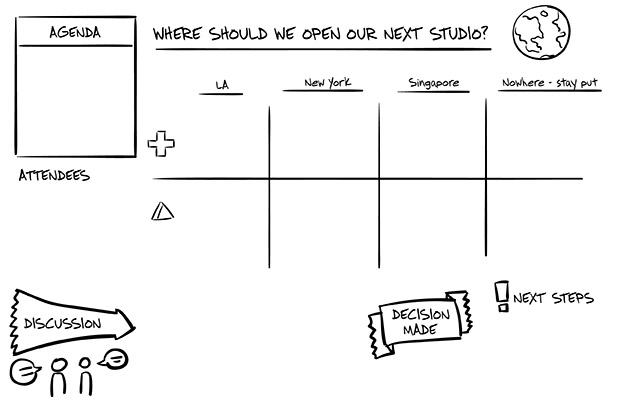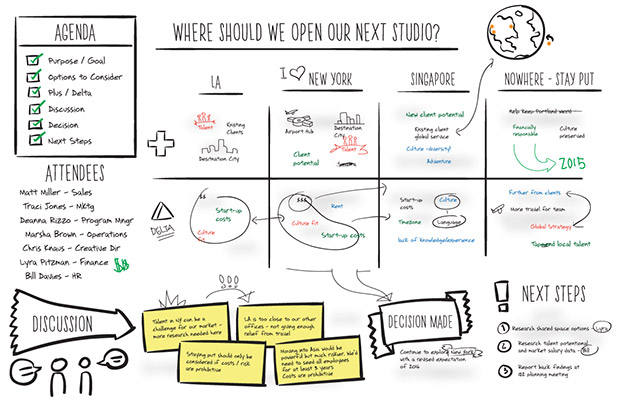Meetings get a bad rap. Late or inattentive attendees, endless recapping and talking in circles with little or no progress made, a waste of everyone’s time. It’s enough to make you ask, “should we abandon meetings all together?”
At XPLANE we believe meetings, when done correctly, can be a valuable tool. The key is in how you plan and execute your meetings. Here’s how XPLANE approaches them.

Decide
First, do you even need to have a meeting? Stop and ask yourself, what am I trying to achieve? Can it be achieved faster or more effectively without calling the meeting?
If you need a meeting, what kind of meeting do you need to have? This will influence everything from meeting location to duration. Most meetings fall within the following categories:
- Decision Making or Problem Solving
- Planning
- Learning or Sharing
- Brainstorming or Co-Creation
Plan
Meetings are generally won or lost before they even start. It’s essential to think through the details of what, who, when, where, and how. For a bulletproof meeting plan, ask yourself these questions:
- What result are you trying to achieve? (This is your goal.)
- What decisions will be required?
- What information is needed to support or inform this meeting?
- Who should have input? (These are your attendees)
- When is the best time (day/month/year) to have this meeting?
- Where should we have this conversation? Boss’ office? A coffee shop? Any old meeting room?
- How much time is required to do this correctly?
- How can you engage the attendees in an effective way such as framing questions, post-up exercises, or visual presentations?
Those answers will begin to inform an agenda: the key ingredient to a successful meeting. Here are some template agendas based on common meeting types:
Decision Making |
Planning |
Brainstorming |
|
|
|
Deliver
How can you engage the attendees in an effective way? Consider creating a meeting canvas. This is a visual framework based off the meeting agenda which will help anchor and hold the meeting together.


As the meeting transpires, fill out the canvas with key decisions and notes. This will focus the energy of the attendees and keep them engaged. It also creates instant documentation of the meeting so meeting notes are already taken care of.
Follow Through
Without follow through, it’s like the meeting never happened. Don’t forget to provide the meeting notes or canvas to attendees with clear actions items and corresponding deadlines. It’s also a best practice to get feedback from attendees on how effective the meeting was so you can continue to tweak and improve for next time.
Doing all of this for a meeting is a lot of work, we know. And not every meeting needs this level of effort, but for the meetings critical to your organization, you’ll get better results and a better experience.
